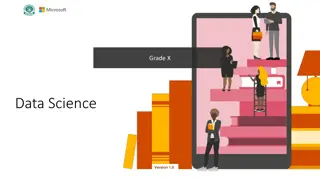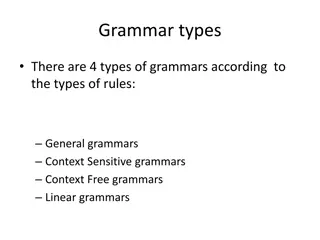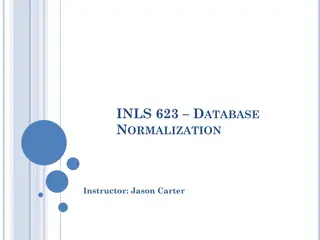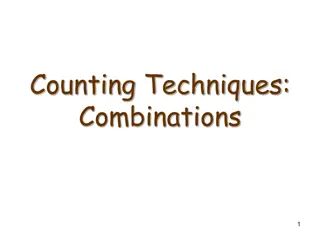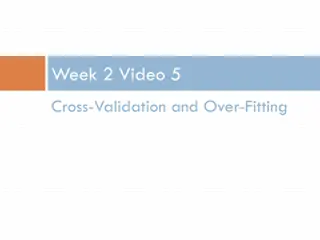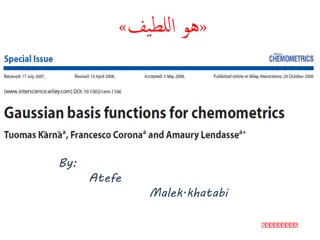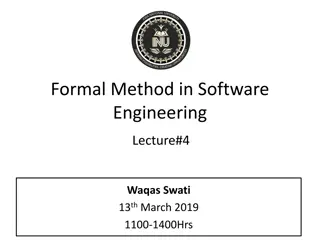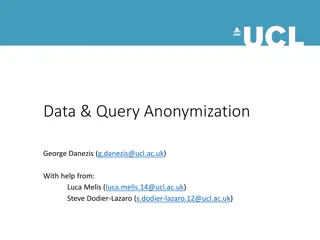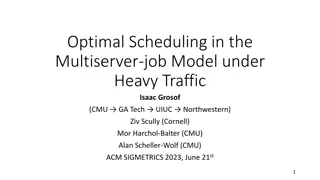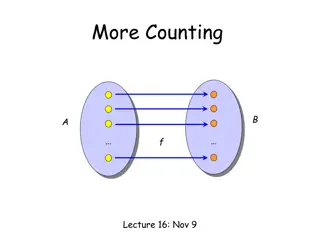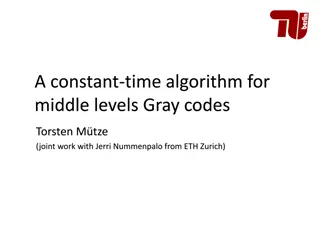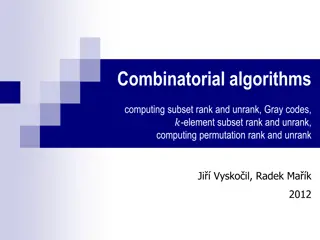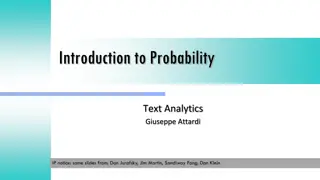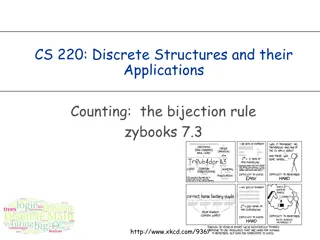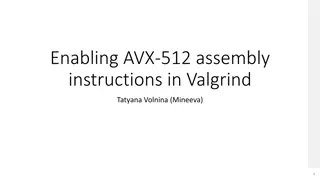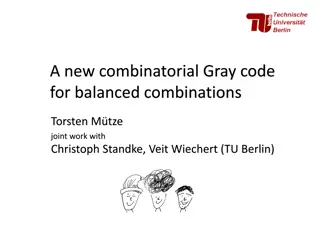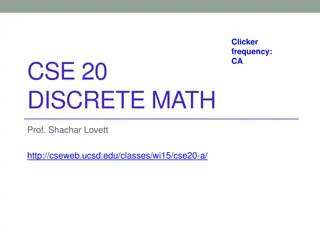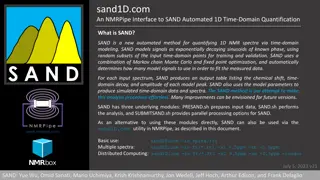Introduction to Probability Concepts in CSE 312 Spring 24 Lecture 5
Today's lecture in CSE 312 Spring 24 covers the basics of probability, including sample spaces, events, and probability calculations. Understand the foundational processes behind quantifying uncertainty, such as flipping coins, rolling dice, and shuffling cards. Dive into concepts like sample spaces
3 views • 26 slides
The Joy of Sets: Graphical Alternatives to Euler and Venn Diagrams
Graphical representations of set membership can be effectively portrayed using alternatives to traditional Euler and Venn diagrams. Learn about upset plots, indicating set membership graphically, and the use of Venn or Euler diagrams as solutions. Explore the historical context and challenges with V
3 views • 43 slides
Introduction to Topological Spaces and Examples
Topology is the study of surfaces derived from Greek words meaning surface and discourse. In mathematics, a topological space is a set with a family of subsets satisfying specific properties. Examples include the open ball, open set, indiscrete topology, discrete topology, co-finite topology, and co
1 views • 14 slides
Subsets and Two-way Frequency Tables in Data Science
Introduction to subsets in data analytics, explaining different ways of subsetting data such as row-based, column-based, and data-based subsetting. Additionally, the concept of two-way frequency tables is explored, highlighting how they display observed frequencies for two variables in a structured
1 views • 45 slides
Equivalence Class Testing and Its Application in Software Testing
Equivalence class testing is a software testing technique that involves dividing input values into classes for effective testing coverage. Equivalence classes are defined mathematically as subsets of a given set, ensuring partitioning and mutual exclusivity. By applying equivalence partitioning, tes
4 views • 21 slides
Equivalence Relations and Partition Induced Relations
The concept of equivalence relations and partition-induced relations on sets are explored. Equivalence relations satisfy reflexivity, symmetry, and transitivity, making them important in various mathematical contexts. The relation induced by a partition of a set is shown to be an equivalence relatio
3 views • 24 slides
Overview of Grammar Types and Chomsky Hierarchy
The four types of grammars are General, Context-Sensitive, Context-Free, and Linear grammars, each recognizing a specific set of languages. Chomsky Hierarchy categorizes these grammars into four levels, indicating subsets of languages they can recognize. Context-free grammars have specific productio
1 views • 17 slides
Database Normalization: Understanding Sets and Normal Forms
Explore the importance of set theory in database design, learn about different types of sets, subsets, and supersets, understand the basics of normalization techniques to efficiently organize data in databases, and discover the common anomalies associated with unnormalized databases.
0 views • 26 slides
How to Download a MicroBIGG-E Table with >100,000 Rows from NCBI Pathogen Detection
Learn how to download a MicroBIGG-E table containing all CARBAPENEM genes found in Pathogen Detection isolate assemblies on NCBI. Follow a step-by-step guide to select, filter, and download subsets of data in batches to get the complete dataset.
0 views • 10 slides
Efficient Test Generation for Large Systems Using SLAM
This research discusses SLAM (SLice And Merge), a method for effective test generation in large systems. It focuses on using test templates to generate test cases efficiently, slicing the system into subsets with different templates assigned to each slice, and merging multiple templates for thorough
0 views • 22 slides
PELICAN: A Building Block for Exascale Cold Data Storage
PELICAN addresses the need for cost-effective storage of cold data in the cloud, offering exabyte-scale storage solutions. By provision resources specifically for cold data workloads, it optimizes storage efficiency and reduces unnecessary resources, resulting in high-density, low-cost storage with
0 views • 30 slides
How to Cite NCBI Pathogen Detection Resource
Learn how to correctly cite the Pathogen Detection Resource and data within NCBI Pathogen Detection. Follow guidelines on citing the entire resource, subsets of data, accessing Isolates Browser & MicroBIGG-E, using NCBI AMR resources, and acknowledging data submitters in your manuscript.
0 views • 8 slides
Discrepancy Minimization in Combinatorial Concepts
Explore the intriguing world of Discrepancy Minimization through concepts like walking on the edges, subsets coloring, arithmetic progressions, and more. Delve into fundamental combinatorial concepts and complexity theory to understand the significance of Discrepancy theory in various fields. Discov
0 views • 33 slides
Combinations and Counting Techniques
Combinations play a crucial role in counting techniques, where subsets of elements are selected without regard for the order. This text explores the concept of combinations, including calculating the number of possible combinations, distinguishing between unordered and ordered selections, and provid
0 views • 11 slides
An Lp Theory for Outer Measures: Application to Singular Integrals II
This discussion covers various topics such as tents (or Carleson boxes), outer measures on the open upper half-plane, sizes of functions on tents, outer essential supremum on subsets, outer Lp spaces, embedding theorems, and estimates related to Linfity-Sinfty and weak L1-Sinfty. The content delves
0 views • 34 slides
Cross-Validation and Overfitting in Machine Learning
Overfitting is a common issue in machine learning where a model fits too closely to the training data, capturing noise instead of the underlying pattern. Cross-validation is a technique used to assess a model's generalizability by splitting data into subsets for training and testing. Strategies to r
1 views • 24 slides
Functional Approximation Using Gaussian Basis Functions for Dimensionality Reduction
This paper proposes a method for dimensionality reduction based on functional approximation using Gaussian basis functions. Nonlinear Gauss weights are utilized to train a least squares support vector machine (LS-SVM) model, with further variable selection using forward-backward methodology. The met
0 views • 23 slides
Adjectives: Types and Examples
Learn about adjectives, words that modify or describe nouns or pronouns. Explore different subsets of adjectives such as proper adjectives, articles, demonstrative adjectives, and other special adjectives. Identify adjectives in sentences and understand how they tell what kind, how many, or which on
0 views • 10 slides
Enhancing Spatial Data Analysis in QGIS
Explore the integration of relational databases with QGIS to facilitate efficient spatial data analysis. Discover the importance of recognizing spatial relationships within data sets and the solutions to enhance QGIS for relational datasets. Overcome challenges and delve into the intersection and su
1 views • 25 slides
Set Theory in Software Engineering Lecture
Sets, relations, and functions are foundational concepts in set theory, which is crucial in software engineering. This lecture covers topics such as types of sets, operations, relations, functions, set cardinality, subsets, and proper subsets. Explore the fundamentals of set theory with practical ap
0 views • 28 slides
Comprehensive Guide to ZIMS for Studbooks User Defined Fields and Labels
Explore the functionalities of User Defined Fields (UDFs) and Labels in ZIMS for Studbooks, allowing users to define subsets of animals for analysis and assign tags or keywords to indicate specific characteristics. Learn how to create and manage UDFs, apply filters, and track unique information abou
0 views • 24 slides
Anonymization Techniques in Data Privacy
Anonymizing data is crucial to safeguard privacy, prevent data breaches, and enable sharing for various use cases, such as statistics, data science, and data release. Techniques like K-anonymity aim to protect individual identities by grouping data into subsets with shared characteristics. However,
0 views • 24 slides
Enhancing Phylogenetic Analysis Using Divide-and-Conquer Methods
Large-scale phylogenetics presents challenges due to NP-hardness and dataset sizes. Divide-and-conquer methods like SATe, PASTA, and MAGUS enable efficient processing of large datasets by dividing, aligning, and merging subsets with accuracy. MAGUS, a variant of PASTA, utilizes a unique alignment me
0 views • 15 slides
New Scheduling Policy: ServerFilling-SRPT in Multiserver Job Model
Discusses a new scheduling policy, ServerFilling-SRPT, designed to favor small jobs in the multiserver job model. The policy aims to minimize mean response time by prioritizing jobs with the least remaining size order and arranging them based on server needs. The approach involves finding minimal su
1 views • 16 slides
Counting Rules and Bijection: Examples and Applications
Explore the concepts of counting rules and bijection through various examples, such as defining mappings for counting, power sets, and bijections between subsets and binary strings. Discover how to determine the number of ways to place chess pieces on a board without sharing rows or columns using ma
0 views • 49 slides
Middle Levels Gray Codes: Loopless Generation Algorithms and Conjecture
Combinatorial Gray codes involve generating combinatorial objects with minimal differences between consecutive objects. The Middle Levels Conjecture focuses on cyclically generating ground set subsets with specific characteristics. This conjecture has led to significant theoretical and experimental
0 views • 15 slides
Combinatorial Algorithms for Subset and Permutation Ranking
Combinatorial algorithms play a crucial role in computing subset and permutation rankings. These algorithms involve defining ranking functions, successor functions, lexicographic ordering on subsets, and permutation representations. The functions SUBSETLEXRANK and SUBSETLEXUNRANK are used for comput
1 views • 22 slides
Introduction to Probability: Key Concepts and Definitions
Explore the fundamental concepts of probability including basic probability, conditional probability, Bayes Theorem, independence, sample space, events, counting, and the definition of probability. Learn about the significance of sample space, event subsets, and how probability laws encode knowledge
2 views • 31 slides
Bijection Rule in Counting Subsets and Functions
Explore the concepts of counting subsets and functions, including injective, surjective, and bijective functions. Discover the bijection rule, which states that if there is a bijection between two finite sets, their cardinalities are equal. Learn about counting palindromes and the k-to-1 rule throug
0 views • 11 slides
Enabling AVX-512 Assembly Instructions in Valgrind by Tatyana Volnina (Mineeva)
Explore the implementation of AVX-512 instructions in Valgrind through detailed agendas, instruction layouts, masking techniques, new features, subsets, and methodologies. Discover how Valgrind enables parsing of assembly instructions for AVX-512 and AVX-2, facilitating code separation and IR genera
0 views • 16 slides
A New Combinatorial Gray Code for Balanced Combinations
This research work by Torsten Mütze, Christoph Standke, and Veit Wiechert introduces a new combinatorial Gray code for balanced combinations, focusing on a-element subsets and flaws in Dyck path representation. The study explores various aspects of balanced combinations, their flaws, and the relati
0 views • 30 slides
Clinical Insights and Debates on Cancer of Unknown Primary Syndrome
DEBATECUP is a clinico-pathological syndrome encompassing various cancer types with occult primaries, each exhibiting predictable responses to therapies once classified. Current evidence supports CUP as a collection of specific cancer types with occult primary sites, posing challenges in primary sit
0 views • 12 slides
Sets and Venn Diagrams in Mathematics
Explore the basics of set theory, elements, lists, subsets, and set operations like union and intersection. Learn about Venn diagrams for visualizing sets and their subsets. Discover how sets are fundamental in mathematics and essential for further studies.
1 views • 14 slides
Discrete Math Concepts and Set Operations Explained
Explore key concepts in discrete math, including set operations, Venn diagrams, and proofs of set equality. Learn about unions, intersections, differences, complements, and more through visual aids and examples. Enhance your understanding of elements, subsets, and set relationships with comprehensiv
1 views • 22 slides
Automated Quantification of 1D NMR Spectra with SAND
SAND is an automated method for quantifying 1D NMR spectra using time-domain modeling by modeling signals as exponentially decaying sinusoids. It uses random subsets of input data for training and validation, combining Markov chain Monte Carlo and fixed-point optimization. SAND determines the number
0 views • 25 slides
Combinatorial Counting and Algorithm Design Concepts
Today's lecture covers the basics of combinatorial counting and its applications in algorithm analysis. Topics include exhaustive search strategies, determining graph properties, and various counting techniques. Techniques such as counting objects and generating subsets are discussed, along with alg
0 views • 20 slides
Systemic sclerosis
Systemic sclerosis, a connective tissue disease, presents with Raynaud phenomenon and varying clinical subsets. Limited and diffuse forms exhibit distinct features such as musculoskeletal symptoms, pulmonary complications, and specific autoantibodies. Understanding these subsets enhances disease man
0 views • 17 slides
Naive Theory of Sets
A set is a collection of elements uniquely determined by its contents. Explore the basic principles of sets, set notation, set operations, and relations between sets. Learn about subsets, proper subsets, set differences, complements, and more in the naive theory of sets.
0 views • 9 slides
Discrete Structures: Sets, Functions, and Definitions
Explore the fundamentals of sets and functions in discrete structures, including definitions, well-known sets, set builders, Venn diagrams, subsets, power sets, Cartesian products, and examples of Cartesian products. Understand concepts such as elements, subsets, cardinality, ordered pairs, and more
0 views • 44 slides
Understanding Block Modeling and Equivalence in Social Structures
Explore the concept of block modeling and equivalence in social structures, uncovering emergent roles and subsets within graphs. Learn about bi-components, factions, and Concor analysis for identifying distinct subsets and relationships. Discover how these methods help analyze and understand social
0 views • 18 slides



